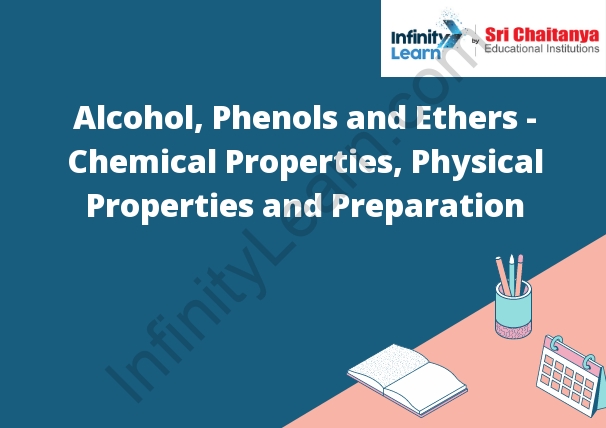Table of Contents
Definition of Alcohols on Infinity Learn
An alcohol is a molecule that contains a hydroxyl functional group (-OH). The simplest alcohol is ethanol, which is the alcohol found in alcoholic beverages.

Physical Properties of Alcohols
Alcohols are a class of organic molecules that contain a hydroxyl group (-OH) attached to a carbon atom. The simplest alcohol is ethanol, which is the intoxicating agent in alcoholic beverages.
The physical properties of alcohols depend on the number of carbon atoms in the molecule. Aliphatic alcohols, those with fewer than six carbon atoms, are colorless, volatile, and flammable. They are soluble in water and have a characteristic odor. Aromatic alcohols, those with six or more carbon atoms, are usually colorless, but some are slightly yellow or red. They are less volatile than aliphatic alcohols and are not as flammable. They are also less soluble in water.
The Acidity of Alcohols
An alcohol is a molecule that contains a hydroxyl group (-OH) bonded to a carbon atom. The simplest alcohol is ethanol, which is the alcohol found in alcoholic beverages.
The hydroxyl group makes alcohols acidic. The more hydroxyl groups an alcohol has, the more acidic it is. This is because the hydroxyl group can donate a proton (H+) to other molecules.
The acidity of alcohols is important because it affects their chemical properties. For example, alcohols can react with carboxylic acids to form esters.
Chemical Properties of Alcohol
An alcohol is a molecule that contains a hydroxyl group (-OH) bonded to a carbon atom. The simplest alcohol is ethanol, which is the alcohol found in alcoholic beverages. Alcohols are polar molecules and are soluble in water. The hydroxyl group makes alcohols amphoteric, meaning they can act as both acids and bases.
Preparation of Alcoholic Beverages
There are a variety of methods that can be used to produce alcoholic beverages. The most common way to produce beer is to mash malted barley with hot water to convert the starch into sugar. The sugary water is then boiled with hops, which add bitterness and flavor, and yeast is added to start the fermentation process. Beer can also be made from other grains, such as wheat or rye, or from fruits such as apples or cherries.
Wine is made by fermenting grape juice. The juice is mixed with yeast and allowed to ferment for a period of time. The resulting wine can be consumed immediately or aged in oak barrels to improve the flavor.
Brandy is distilled from wine or other fermented fruit juice. The distillation process separates the alcohol from the water and other components of the juice. Brandy is often aged in oak barrels to improve the flavor.
Phenols
Phenols are a type of organic compound that share a common functional group. They are composed of a benzene ring substituted with one or more hydroxyl groups. This makes them soluble in water and able to dissolve other compounds. Phenols are found in many plants and are responsible for their medicinal properties.
Physical and Chemical Properties of Phenol
Phenol is a colorless, crystalline solid with a characteristic odor. It is soluble in water and alcohol, and slightly soluble in ether. It is a weak acid, and is corrosive to metals.
Phenol is highly toxic and can cause severe burns to the skin and eyes. It is a carcinogen, and can cause cancer.
Preparation of Phenol
Phenol is prepared by the oxidation of benzene using oxygen in the presence of a copper catalyst. The overall reaction is:
2C6H6 + 7O2 → 2CO2 + 6H2O
The reaction is exothermic, and a large quantity of heat is released. The reaction mixture is cooled in order to prevent it from boiling over.
Ethers
Ethers are a type of digital asset that can be used to pay for goods and services on the Ethereum network. They are similar to bitcoins, but ethers can also be used to pay for computations on the Ethereum network.
Bitcoins
Bitcoins are a type of digital asset that can be used to pay for goods and services on the Bitcoin network. They are similar to ethers, but bitcoins can also be used to pay for computations on the Bitcoin network.
Physical Properties of Ethers
The boiling points of ethers are lower than those of the corresponding alcohols. The melting points of ethers are also lower than those of the corresponding alcohols.
The molecular weights of ethers are lower than those of the corresponding alcohols.
The densities of ethers are lower than those of the corresponding alcohols.
Chemical Properties of Ethers
The chemical properties of ethers are very similar to the chemical properties of alcohols. Ethers are also polar molecules, and they are also soluble in water. Ethers are also relatively stable molecules, and they are not as reactive as alcohols.
Preparation of Ethers
Ethers are prepared by the action of an alkyl halide on an alcohol in the presence of a base. The alkyl halide is converted into the corresponding alkyl iodide, which then reacts with the alcohol to give the ether.
The reaction is illustrated below for the preparation of diethyl ether from ethanol.
The reaction is carried out in the presence of a base, such as sodium hydroxide, which converts the alcohol into the corresponding alkoxide ion. The alkoxide ion then reacts with the alkyl iodide to give the ether.
The reaction can also be carried out in the presence of a Grignard reagent, such as magnesium ethyl ether, which can be used to prepare more complex ethers.
The reaction is illustrated below for the preparation of tetrahydrofuran from ethylene glycol.
The Grignard reagent magnesium ethyl ether reacts with the ethylene glycol to give the ether.









